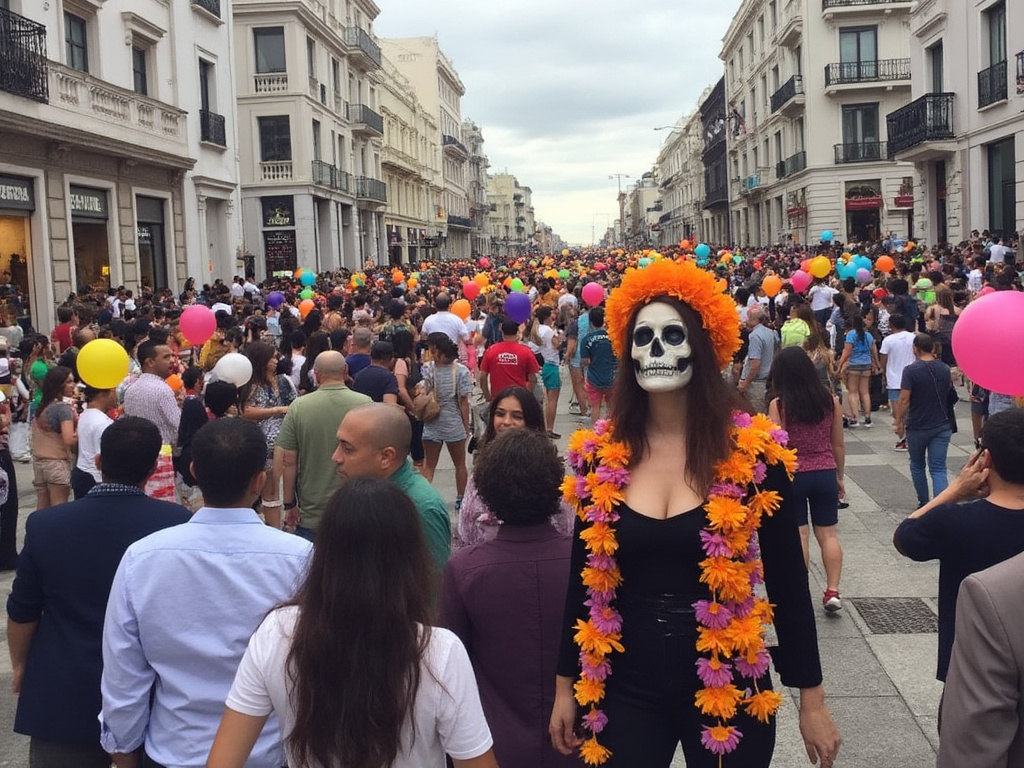Día de los Muertos, or the Day of the Dead, is a unique cultural celebration in Mexico that combines vibrant traditions, heartfelt rituals, and unforgettable artistry. Every November 1st and 2nd, Mexico City transforms into a colorful tribute to loved ones who have passed away. For TESOL teachers, experiencing Día de los Muertos firsthand offers an incredible opportunity to connect with Mexican culture, gain insight into local customs, and incorporate cultural awareness into their English lessons.
What is Día de los Muertos?
Día de los Muertos, a holiday with roots in Aztec culture and blended with Catholic traditions, is a joyful celebration honoring the deceased. Far from being a time of mourning, it’s a vibrant festival where families remember loved ones with joy, food, and festivities. People celebrate in cemeteries, plazas, and homes throughout Mexico, but Mexico City is particularly famous for its elaborate displays, parades, and ofrendas (altars).
Highlights of the Celebration in Mexico City
1. Building Ofrendas
Ofrendas are beautifully decorated altars that families set up in homes or public spaces. These altars include photos of the departed, marigold flowers (cempasúchil), candles, and incense to guide spirits back to the living. Families place the favorite foods and drinks of their loved ones on these altars as offerings, representing the spirit’s chance to enjoy these pleasures once more.
Fun Fact: Marigolds are called the “flowers of the dead” in Mexico. Their bright orange and yellow colors and strong scent are believed to help guide the spirits back to their families.
2. Calaveras (Decorative Skulls)
Skulls, or calaveras, are a prominent symbol of Día de los Muertos. You’ll see beautifully painted skulls made of sugar, chocolate, or clay, adorned with intricate designs. In Mexico City, artistic skulls are displayed in markets, museums, and plazas, adding a festive and colorful touch to the holiday.
Fun Fact: Sugar skulls often have names inscribed on the forehead, either the name of the deceased or of a living person. This tradition symbolizes mortality and reminds people of the cycle of life and death.
3. Parades and Performances
Mexico City hosts grand parades, with people dressed in stunning costumes inspired by La Catrina—a popular skeleton figure in Mexican culture. These parades are filled with dancers, musicians, and participants with faces painted like skeletons. The atmosphere is lively, blending music, dancing, and costumes to celebrate life and death together.
4. Nighttime Cemetery Visits
Many families visit cemeteries on the nights of November 1st and 2nd, bringing flowers, candles, and food to their loved ones’ graves. In some cemeteries, music and dancing continue through the night, creating a sense of community and remembrance.
Fun Fact: In the cemetery, people may even sit at the graves of loved ones, eating and sharing stories. The goal is to reconnect with those who have passed, celebrating their lives as though they are still present.
Teaching Opportunities for TESOL Teachers
Día de los Muertos is a meaningful cultural event that TESOL teachers can bring into the classroom in various ways:
- Vocabulary Building: Teach words like “altar,” “marigold,” “calavera,” and “ofrenda” through stories and pictures.
- Cultural Discussions: Have students discuss how they honor loved ones and compare it to Mexican traditions. It’s a great way to explore different cultural practices around death and remembrance.
- Art and Crafts: Create paper marigolds or design decorative skulls. This hands-on activity helps students engage with the cultural symbols of Día de los Muertos.
- Storytelling: Share folktales related to Día de los Muertos or have students write about how they would build an ofrenda for someone they admire.
How to Teach English in Mexico City
For TESOL teachers, experiencing Día de los Muertos firsthand in Mexico City is a unique and enriching opportunity. American TESOL offers certification programs that prepare teachers to work abroad, providing training, job placement, and resources to help you succeed. If you’re interested in teaching in Mexico City, learning more about the local culture will not only deepen your own experience but also help you connect with your students.
By embracing celebrations like Día de los Muertos, TESOL teachers can bring a greater understanding of Mexican culture into the classroom and foster an environment of cultural exchange and respect. So, consider taking part in this beautiful celebration—it’s an experience that will stay with you and enrich your teaching journey.



